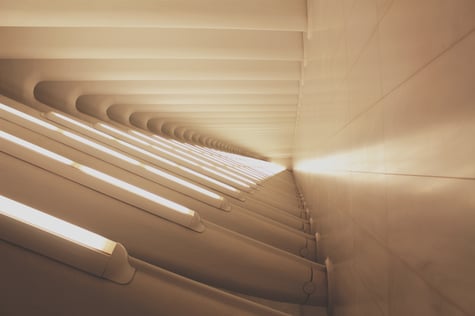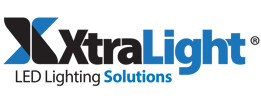
To help buyers make better purchasing decisions, we're taking a look at the most popular lighting technologies available today – and what effect they have on your business. Today we're talking about the popular fluorescent or CFL (compact fluorescent light) bulbs. These were some of the first light bulbs designed for commercial enterprises and saving money: How do they compare?
Science of Fluorescents
Fluorescent bulbs use a very different type of technology than incandescents: A sealed bulb (originally, long tubes were used because they were the ideal shape for the right kind of chemical reaction) is filled with a combination of gases including argon, xenon, and mercury vapor. At either end of the bulb a cathode is placed so that an electrical current can travel through the gases. This creates radiant energy as the gas atoms are energized, but not the kind that human eyes can see. To create visible light, fluorescent bulbs are covered in a white phosphor coating. When the energized gas atoms hit this coating, the coating in turn is energized and produces a glowing, whitish light that can be see by people. Different combinations of gases and phosphor coatings can change the shade of light.
It sounds like a lot of trouble for a simple light bulb, right? But there are many benefits. The biggest advantage is a design that saves a significant amount of electricity, using around 1/5 the electricity of incandescents. Fluorescents are also more versatile; they can support dimming features and can be made into many different bulb shapes with a wide variety of purposes, including replacing incandescents using the same socket.
Brief History
Scientists were experimenting with mercury gas and electricity in the late 1800s to confirm theories that had been around for decades. However, it wasn't until the early 1900s that successful fluorescent lamps, particularly out of Germany were created. World War II and the vast evolution of manufacturing technology finally made the bulbs a commercial possibility, where they began to appear in offices and industrial facilites. It wasn't until the 1970s, however, that manufacturers responded to the looming oil/financial crisis by developing fluorescent bulbs for residential use, which soon led to the CFL market. As the 21st century dawned, fluorescent technology focused on making safer CFLs with better light colors.
Things to Consider
-
Classifications
- There are many different classifications for fluorescent lights, from the early model T12s to the smaller, modern T5s and beyond. T8 and T5H0 models are generally good for commercial purposes, but it's important to find the bulbs that are the best for your particular business.
-
Humming
-
- When many people think of fluorescent bulbs, they think of flickering lights that are slow to turn on and hum constantly. Fortunately, this is only true of old fluorescent bulbs with 60-hertz magnetic ballasts that have slow electrical charge cycles. Today's fluorescents have better ballasts with higher hertz, which means a fast response and no humming.
-
Bulb Warmth
Fluorescent bulbs also have a reputation of being "cold" and casting products in less favorable lights. Again, however, modern fluorescents have dealt with this problem by offer bulbs in a number of colors. Pay close attention to bulb temperature (a metric to judge color) when purchasing fluorescents. -
Safety
Mercury is a dangerous, highly toxic element, and even more dangerous is gaseous form. This is why broken fluorescent bulbs need to be handled with care, and why areas where bulbs have broken should be avoided. If you are worried about safety standards at work, then modern LED lights can provide a much safer option.
The Future of Fluorescents
After a couple decades of high popularity and widespread use, fluorescent bulbs face a crossroads. While they are still known for energy savings and supported by a number of government programs, they are also difficult to manufacture and have some safety problems. Lately fluorescents have lost the spotlight to safer, cheaper, longer-lasting LED lights. However, fluorescents still have an important role in offering energy-efficient solutions for businesses and homes that still use incandescent sockets and need compatible CFL bulbs.
Catch up with part one of The Waves of Lighting Technology - Incandescent and be on the lookout for the final part of this series on LEDs coming next week!
Want to stay illuminated about LED lighting technologies? Be sure to sign up for weekly blog notificatons at the top of this page!



